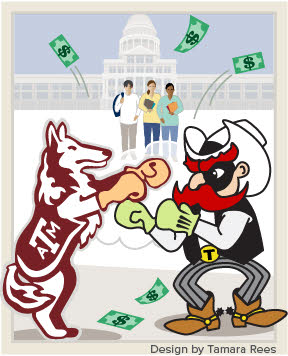
Boxing graphic

The Red Raider-Aggie relationship is strained as Texas Tech pushes to open the second veterinary medical school in the state. Tech officials assert that the fight is one-sided, even as A&M lobbies against the fledgling program. "There's room for us both," said Dr. Guy Loneragan, a Texas Tech administrator.
As Texas Tech University in Amarillo forges ahead with plans to open what could be the nation's 31st veterinary school, Texas A&M University asserts that the Lone Star State isn't big enough for two programs.
Tech plans to break ground on the $90 million project next year, armed with $69 million in pledges from the Amarillo Economic Development Corporation and $21 million from private donors. A consultative site visit by the Council on Education, the nation's accrediting body for veterinary education, is slated for April. The new program could admit its inaugural class of 40 students by fall 2021, if all goes as planned.
The Texas Tech University System Board of Regents formally approved the program's concept and allocated $1.37 million for preliminary designs just last week, but the idea of opening a veterinary school at Tech isn't new. Talk arose in the 1960s, but the initiative took a back seat to building a medical school, which opened in 1969. A half-century later, plans for the veterinary college are coming to fruition.
Still, the veterinary school's prospects aren't entirely clear. Tech Chancellor Robert Duncan, one of the veterinary school's biggest advocates, accounced Monday that he would retire from his position, effective Aug. 31. According to a local media report, "friction" concerning the new school played a role in his exit. A former Texas lawmaker, Duncan has used his influence to generate support for the veterinary school. Last year, the state Legislature allocated $4.2 million in seed money for it. Duncan was expected to help secure approximately $17 million for program operations over the next two years when the Legislature convenes in January. A yearly operating budget of $19.5 million is anticipated should Tech's veterinary program become established.
Overseeing its development is Dr. Guy Loneragan, a veterinary epidemiologist and professor of food safety and public health at Tech who's serving temporarily as the veterinary school's administrator. He says Duncan worked "tirelessly" to advance higher education in Texas, and his departure does not diminish the program's importance.
"Chancellor Duncan is a man of vision, persistence and utmost integrity, and he is a servant leader the likes of which few have the privilege to work," he said by email. "He, and the leadership at Texas Tech University and Texas Tech University Health Sciences Center, have laid the ground work for the success of the veterinary school. The Board, before his announcement to retire, approved creation of the school, submission of the degree proposal to our state regulatory body, and the budget to advance the facilities through complete design documents. In addition, Texas Tech submitted our request for operational start-up support to the state Legislature."
The community, he added, is full of anticipation. "As we have developed this program into something granular and tangible for communities and practitioners and livestock producers to see, the level of excitement continues to grow," he said. "The state now has appropriated funds for us … the first time in history. And that really is an indication that the state sees this as a priority."
To inform Texas veterinarians on plans, advocates for the fledgling school are planning an informational tour throughout the state. Presentations will cover Tech's plans to address a shortage of practitioners in agricultural communities and provide aspiring veterinarians in the state with a second in-state option for education.
While the presentations may draw supporters and people curious to learn more, they also are likely to attract skeptical Aggies — members of Texas A&M University community and alumni. Texas A&M has operated the state's only veterinary school, in College Station, for more than a century, and has graduated approximately 60 percent of the 10,000-plus veterinarians licensed to practice there.
Aggie officials are working hard to keep it that way.
More than 500 miles southeast of Tech's campus, Dr. Eleanor Green, dean of the A&M College of Veterinary Medicine & Biomedical Sciences, is spreading her message that a second school isn't needed to cater to large animals and rural practices. Officials with the A&M System say it has veterinary education cornered, with plans to invest $90 million in educating veterinarians at its West Texas A&M campus in Canyon, just minutes from where Tech plans plans to open its veterinary school in Amarillo. The new Veterinary Education, Research & Outreach Center in Canyon is slated to provide students from Texas A&M's veterinary college with the opportunity to take courses, participate in externship programs and conduct research in the Panhandle by 2020.
Green warns that two state-supported programs would dilute legislative appropriations.
Texas A&M's veterinary teaching hospital alone has an annual operating budget of more than $17 million, mostly funded by hospital revenues. Eighteen percent of the hospital's budget is received from the state. Overall, 19 percent of the university's operating funds come from state allocations.
"Ample state support for two colleges of veterinary medicine would be a challenge, especially on a recurring basis," Green said by email. "State funding is finite and often relatively static with multitudes of competing demands, such as health care, K-12 education, infrastructure, social services and more. It is fair to be concerned that a second state supported veterinary college in Texas could adversely affect funding for the Texas A&M College of Veterinary Medicine & Biomedical Sciences … It is also fair to assume that Texas Tech would face competing priorities for funding internally among its existing programs."
Green continued, "It is highly unusual for there to be more than one state supported college of veterinary medicine in a state, especially one that depends heavily upon state support."
That's a hollow argument, Loneragan countered. Two publicly funded veterinary schools coexist at Tuskegee and Auburn universities in Alabama. What's more, funding veterinary schools isn't an either-or proposition in Texas, he said.
"The way that veterinary programs in Texas are funded," he said, "is that state allocations for the 34 general academic campuses in Texas are primarily put in a pool of funds that's approximately $4 billion over the biennium. All of the general academic programs, including veterinary medicine, draw from it based on a weighted, semester credit-hour formula, with the weight varying by program. So in that sense, there is not a separate vet school pool that would be divided.
"Texas has a long history of investing in programs deemed important," he continued. "We now have 11 medical schools in Texas; and seven of the most affordable medical programs for students in the country are located here."
Tech aims to rank among the nation's most cost-efficient veterinary schools with in-state tuition around $21,000 a year, Loneragan said. To keep costs low, the program isn't building a veterinary teaching hospital. Plans include a limited distributive model of veterinary education, where students would rotate through private practices, dairies and feedlots — oftentimes staffed by Tech faculty — to learn clinical skills. "Our goal is to have a distributive network sufficient enough to handle the curriculum needs in their final year but also limited enough so we can interact with and invest in our partners to ensure the quality of education and address the needs of the students," Loneragan said.
By comparison, Texas A&M has both small and large animal teaching hospitals, and resident tuition for first-year students is $24,160. At private institutions, veterinary education can cost three times as much. Among the most expensive programs is Midwestern University in Glendale, Arizona, where tuition and fees total $61,921 this year.
Given that most new veterinarians graduate with six-figure student loan debt, Loneragan aims to build a program that is cost-efficient and teaches the skills veterinarians need to generate income right out of school.
"Obviously, we're focused on the cost of education, and that needs to be addressed," he said. "One of the beauties of starting a program from scratch is you don't have to invest in legacy programs."
Addressing a need
A tenet driving Tech's program is to train veterinarians to work in the state's underserved rural communities in the state's agricultural center. Amarillo is known as the beef capital of the world, home to roughly 2.5 million head of cattle within a 150-mile radius. Throughout the area are more than a million hogs and nearly as many sheep. West Texas also has emerged as one of the largest milk-producing regions in the nation.
There are more humans, too.
"Texas is approaching 30 million people; we're bringing in 1,000 each day, and those families are bringing in pets," Loneragan said. "There is no developed country of this size in the world that relies on one vet school. In Texas, we now import three-fourths of our workforce needs. Veterinarians are relocating to Texas because we have jobs here.
"The workforce demand is clear, but so is the need for education," he continued. "We now have more Texans enrolled in out-of-state schools than in-state schools because the demand for education has outstripped capacity."
Veterinary regulators estimate that fewer than 200 licensees practice in the Panhandle. In a 2016 report by the Texas Higher Education Coordinating Board, the agency concluded that there was a need for more veterinarians but rejected the prospect of opening a second program.
"No new college of veterinary medical education is recommended at this time," the report stated.
Instead, the report suggested addressing the "pending shortage" in a variety of ways that includes creating a baccalaureate degree in veterinary science that permits a greater scope of practice; funding incentives to work in rural areas; and developing a program to produce large-animal veterinarians in a cost-effective manner that "does not duplicate existing efforts."
Loneragan asserts that the Tech program in no way mimics A&M's veterinary school, "just like most medical schools in Texas are distinct from one another."
Green disagrees, calling the program "redundant."
A&M has responded to the report of a pending shortage by developing its West Texas branch and adding 30 seats to its first-year class. The program received 478 "qualified" applicants in 2017, to which it offered admission to 158. For fall 2019, the number of first-year students will be 162, making A&M the largest veterinary school in the country. The Ohio State University's veterinary college is a close second at 160 seats for first-year students.
Enlarged class sizes are not an anomaly. Nearly every veterinary program enrolls more students than it did a decade ago. Texas is second in the nation, behind California, in numbers of first-year veterinary students — many of them exported to other programs.
"Even after accounting for the proposed expansion to approximately 162 seats per class, the existing DVM-granting institution within Texas is not keeping up with — and cannot keep up with — the number of new veterinarians needed in Texas," reads a feasiblity report released by Tech in May. "The continued and robust growth of Texas' population, economy and animal-agricultural industries have exceeded the capacity of any single institution."
Tech's answer isn't to go big. To emphasize quality of education within a limited focus to select, train and produce veterinarians that serve agricultural communities, just 60 students will be admitted per class — all Texas residents — once the program is at full capacity. The school also will serve up to 200 graduate students who are not seeking a doctorate in veterinary medicine. The student-to-faculty ratio is anticipated to be 4- or 5-to-1, Loneragan said.
Tech wouldn't be able to force graduates to practice in rural areas, of course. Loneragan said the school's plan is to select candidates who have an affinity for rural life.
"We aim to select the type of student with the attributes and life experiences that suggest they have the aptitude to go into these rural communities," he said.